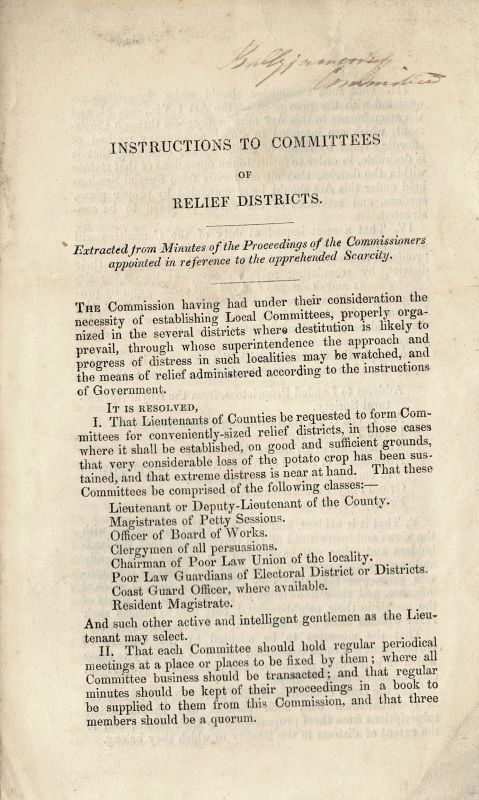Kennedy, Instructions to Committees of Relief Districts - Extracted from Minutes
Instructions to Committees of Relief Districts – Extracted from Minutes of the Proceedings of the Commissioners appointed in reference to the apprehended Scarcity.
[Dublin Castle], 28th February, 1846. Octavo. 4 Pages. Softcover / Original Pamphlet. Historical publication of great scarcity and importance. With manuscript notification to front and one annotation within the text. Very good condition with only minor signs of wear. Provenance: From the private collection of Irish cardiologist and clinical scientist, Eoin O’Brien
The temporary Relief Commission was established in November 1845 in response to the failure of the potato crop, to administer temporary relief supplementary to that provided by the Poor Relief (Ireland) Act, 1838.
The members of the first Commission represented the various government departments in Ireland which were expected to co-ordinate relief:
Colonel Duncan McGregor, police commissioner
Sir James Dombrain, Inspector General of the Coast Guard
Edward B Twistleton, a poor law commissioner
Sir Randolph Routh of the Commissariat Department of the Army
Colonel Harry Jones of the Board of Works
Sir Robert Kane, a distinguished scientist
Theobald McKenna, Assistant Under Secretary and
Edward Lucas, Under Secretary
Captain John Pitt Kennedy, former Secretary of the Devon Commission acted as secretary
The Commission was reorganised in January 1846, disbanded in August 1846 and reconstituted in February 1847 under the Temporary Relief Act with Jones, McGregor, Twistleton, Routh and Thomas Redington, Under Secretary, as members.
The remit of the Relief Commission was to advise the government as to the extent of potato loss and distress within Ireland, to oversee the storage and distribution of Indian corn and meal and to direct, support and co-ordinate the activities of local relief committees. The Commission collected information from all local official sources regarding the advance of the potato disease and the condition of the populace. Reports were received from lieutenants of counties, resident magistrates, poor law guardians, the constabulary and the coast guard. These were collated and used to calculate the probable extent of food shortages.
Local relief committees were established on foot of instructions issued by the Relief Commission in February 1846. These were voluntary bodies consisting of local dignitaries, county officials, poor law guardians and clergymen. Their main duties were to encourage local employment, raise subscriptions and to purchase and distribute Indian corn from the depots established by the Relief Commission. The relief committees were financed by local voluntary subscriptions and could apply to the Lord Lieutenant for grants in proportion to the money subscribed locally. The Relief Commission instructed local committees to publish their subscription lists so as to discourage non-compliance by recalcitrant landowners. They were also directed to maintain lists of residents in every townland, noting the personal circumstance of each and were allowed to issue tickets of employment for public works. This function passed subsequently to the Board of Works, following allegations of mismanagement and the relief committees were limited to compiling lists of those eligible for employment. By August 1846, some 650 committees had been established. The majority were in the south and west of the country. There were fewer in the midlands and east and none in Armagh, Fermanagh, Londonderry and Tyrone. Local committees were also reorganised on foot of the Temporary Relief Act, 1847.
The Relief Commission was one of the main components of the Peel administration’s official response to the Famine. The replacement of Peel with the Whig administration of Lord John Russell and the deepening crisis saw the other components of relief – the public works and the poor law system – assume greater significance and limited the role of the Commission as the central relief authority.
The collection is broadly broken down into an administrative series, a series of distress reports from the constabulary, resident magistrates, lieutenants of counties, and local officials. There is a further series of incoming letters which is broken down into two sub-series: straight numerical from the beginning of the Commission’s activities until August 1846, and, when the commission was re-constituted in February 1847, on a baronial basis. They were mainly from local relief committees, lieutenants and deputy lieutenants of counties, local clergy and concerned citizens. There is also a series of constabulary returns from May 1846, a selection of returns from relief committees and reports from county inspecting officers.
As the listing of the papers of the Relief Commission is ongoing, the arrangement is under revision and the main series of inward correspondence is being entered on a database. The collection is available for consultation in the National Archives, and although there is not as yet a comprehensive list available, every effort will be made to facilitate researchers. (Source: National Archives of Ireland).
- Keywords: Catalogue Irish History Three – From Famine to Free State · Catalogue Irish History Two – Origins of Irish Identity · Eoin O’Brien Medical History Collection (Cardiology etc.) · Famine · Famine, 1845-1852 · Irish Famine · Irish History in the 19th century · Irish Poor Law · Irish Potato Famine · Irish Potatoe Famine
- Language: English
- Inventory Number: 31826AB
EUR 840,--
© 2025 Inanna Rare Books Ltd. | Powered by HESCOM-Software










